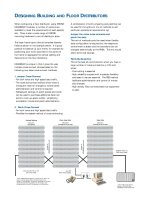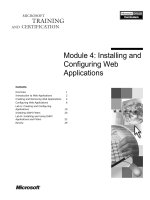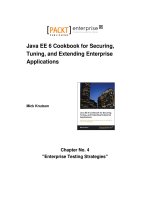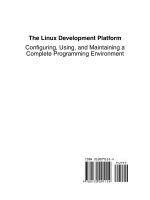Eclipse Rich Client Platform: Designing, Coding, and Packaging Java™ Applications docx
Bạn đang xem bản rút gọn của tài liệu. Xem và tải ngay bản đầy đủ của tài liệu tại đây (8.5 MB, 2,021 trang )
Eclipse Rich Client Platform:
Designing, Coding, and
Packaging Java™ Applications
Table of Contents
Copyright
The Eclipse Series
Titles in the Eclipse Series
Foreword by John Weigand
Foreword by Jeff Norris
Acknowledgments
Preface
About this Book
Audience
Sample Code
Conventions
Feedback
Part I: Introduction
Chapter 1. Eclipse as a Rich
Client Platform
Section 1.1. Eclipse
Section 1.2. The Eclipse Rich
Client Platform
Section 1.3. Eclipse RCP Over
the Years
Section 1.4. Uses of RCP
Section 1.5. Summary
Chapter 2. Eclipse RCP
Concepts
Section 2.1. A Community of
Plug-ins
Section 2.2. Inside Plug-ins
Section 2.3. Putting a System
Together
Section 2.4. OSGi Framework
Section 2.5. The Runtime
Section 2.6. SWT
Section 2.7. JFace
Section 2.8. UI Workbench
Section 2.9. Summary
Part II: RCP by Example
Chapter 3. Tutorial
Introduction
Section 3.1. What Is
Hyperbola?
Section 3.2. The Evolution of
Hyperbola
Section 3.3. Development
Environment Installation
Section 3.4. Target Setup
Section 3.5. Checkpoint
Section 3.6. Sample Code
Section 3.7. Learning by
Example
Section 3.8. Summary
Chapter 4. The Hyperbola
Application
Section 4.1. Hyperbola Hello
World
Section 4.2. Tour of the Code
Section 4.3. Running and
Debugging
Section 4.4. Summary
Chapter 5. Starting the
Hyperbola Prototype
Section 5.1. Continuing from
the Shell
Section 5.2. Adding a Contacts
View
Section 5.3. The Chat Model
Section 5.4. Filling in the
Contacts View
Section 5.5. Adding Images
Section 5.6. Summary
Section 5.7. Pointers
Chapter 6. Adding Actions
Section 6.1. Adding to the
Menus and Toolbar
Section 6.2. Adding to the
Status Line
Section 6.3. System Tray
Integration
Section 6.4. Summary
Section 6.5. Pointers
Chapter 7. Adding a Chat
Editor
Section 7.1. Views and Editors
Section 7.2. Defining the Chat
Editor
Section 7.3. Checkpoint
Section 7.4. Summary
Section 7.5. Pointers
Chapter 8. Branding Hyperbola
Section 8.1. Defining the
Hyperbola Product
Section 8.2. Window Images
Section 8.3. Customizing the
Launcher
Section 8.4. Splash Screen
Section 8.5. About Information
Section 8.6. Summary
Chapter 9. Packaging
Hyperbola
Section 9.1. Exporting
Hyperbola
Section 9.2. Exporting for
Other Platforms
Section 9.3. Summary
Section 9.4. Pointers
Chapter 10. Messaging Support
Section 10.1. Integrating a
Third-Party Library
Section 10.2. Refactoring the
Model
Section 10.3. Updating the UI
Section 10.4. Chatting with
Eliza
Section 10.5. Summary
Chapter 11. Adding a Login
Dialog
Section 11.1. Adding the Login
Dialog
Section 11.2. Remembering
Login Settings
Section 11.3. Adding Auto-
login Preferences
Section 11.4. Summary
Chapter 12. Adding Key
Bindings
Section 12.1. Defining
Commands
Section 12.2. Checkpoint
Section 12.3. Adding Key
Bindings for Workbench
Actions
Section 12.4. Key
Configurations
Section 12.5. Keys Preference
Page
Section 12.6. Summary
Chapter 13. Adding Help
Section 13.1. Adding to the
Target Platform
Section 13.2. Getting the Help
Plug-ins
Section 13.3. Configuring the
Help Plug-ins
Section 13.4. Add the Help
Action
Section 13.5. Adding Help
Content
Section 13.6. Help Content
Structure
Section 13.7. Infopops or F1
Help
Section 13.8. Exporting Plug-
ins with Help
Section 13.9. Summary
Section 13.10. Pointers
Chapter 14. Adding Update
Section 14.1. Getting Update
Plug-ins
Section 14.2. Configuring the
Update Plug-ins
Section 14.3. Defining Features
Section 14.4. Branding
Features
Section 14.5. Adding Update
Actions
Section 14.6. Automatic
Updates
Section 14.7. Summary
Part III: The Workbench
Chapter 15. Workbench
Advisors
Section 15.1. What Is an
Advisor?
Section 15.2.
WorkbenchAdvisor
Section 15.3.
WorkbenchWindowAdvisor
Section 15.4.
ActionBarAdvisor
Section 15.5. Workbench
Overview
Section 15.6. Summary
Chapter 16. Perspectives,
Views, and Editors
Section 16.1. Perspectives
Section 16.2. Views and
Editors
Section 16.3. Multiple
Workbench Windows
Section 16.4. Drag and Drop
with Editors
Section 16.5. Summary
Chapter 17. Actions
Section 17.1. Overview
Section 17.2. Declarative
Actions in Hyperbola
Section 17.3. Standard
Workbench Actions
Section 17.4. Retargetable
Actions
Section 17.5. Consolidating
Declarative Actions
Section 17.6. Toolbar Action
Tricks
Section 17.7. Adding
Contributions to the Status Line
Section 17.8. Reporting
Progress
Section 17.9. Summary
Chapter 18. Customizing
Workbench Windows
Section 18.1. Customization
Defined
Section 18.2. Customizing a
Workbench Window
Section 18.3. Custom Window
Shapes
Section 18.4. Summary
Chapter 19. Customizing the
Presentation of Views and
Editors
Section 19.1. Presentations
Section 19.2. Sample
Presentations
Section 19.3. Writing a
Presentation
Section 19.4. Example
Presentation
Section 19.5. Summary
Part IV: Development
Processes
Chapter 20. Integrating Code
Libraries
Section 20.1. Plug-ins as JARs
Section 20.2. Bundling by
Injection
Section 20.3. Bundling by
Wrapping
Section 20.4. Bundling by
Reference
Section 20.5. Troubleshooting
Classloading Problems
Section 20.6. Summary
Chapter 21. Installing and
Updating Plug-ins
Section 21.1. Update's Roles
Section 21.2. Features
Section 21.3. Creating and
Managing Update Sites
Section 21.4. Example:
Dynamic Content Handling
Section 21.5. Summary
Section 21.6. Pointers
Chapter 22. Dynamic Plug-ins
Section 22.1. Making
Hyperbola Dynamic
Section 22.2. Dynamic
Challenges
Section 22.3. Dynamic-
awareness
Section 22.4. Dynamic-
enablement
Section 22.5. Summary
Chapter 23. RCP Everywhere
Section 23.1. Sample Code
Section 23.2. The Scenario
Section 23.3. Product
Configurations
Section 23.4. Hyperbola
Product Configurations
Section 23.5. Code Structure
Section 23.6. Designing a
Platform
Section 23.7. RCP-friendly
Plug-ins
Section 23.8. Summary
Chapter 24. Building
Hyperbola
Section 24.1. What Is PDE
Build?
Section 24.2. Plug-in
build.properties
Section 24.3. Feature
build.properties
Section 24.4. Setting Up a
Hyperbola Builder
Section 24.5. Running the
Builder
Section 24.6. Building Products
Section 24.7. Cross-platform
Building
Section 24.8. Tweaking the
Build
Section 24.9. Summary
Chapter 25. The Last Mile
Section 25.1. Archives
Section 25.2. Native Installers
Section 25.3. Java Web Start
(JNLP)
Section 25.4. Update Sites
Section 25.5. Initializing the
Install
Section 25.6. Pre-initialized
Configurations
Section 25.7. Multi-user Install
Scenarios
Section 25.8. Summary
Section 25.9. Pointers
Part V: Reference
Chapter 26. OSGi Essentials
Section 26.1. OSGi and the
Eclipse Runtime
Section 26.2. The Shape of
Plug-ins
Section 26.3. Fragments
Section 26.4. Version
Numbering
Section 26.5. Services
Section 26.6. Singletons
Section 26.7. Bundle Lifecycle
Section 26.8. Early Activation
Section 26.9. Auto-activation
Section 26.10. Classloading
Section 26.11. Data Areas
Section 26.12. Putting It All
Together
Section 26.13. Summary
Chapter 27. Eclipse.org Plug-
ins
Section 27.1. Where to Find
Plug-ins
Section 27.2. Eclipse Platform









